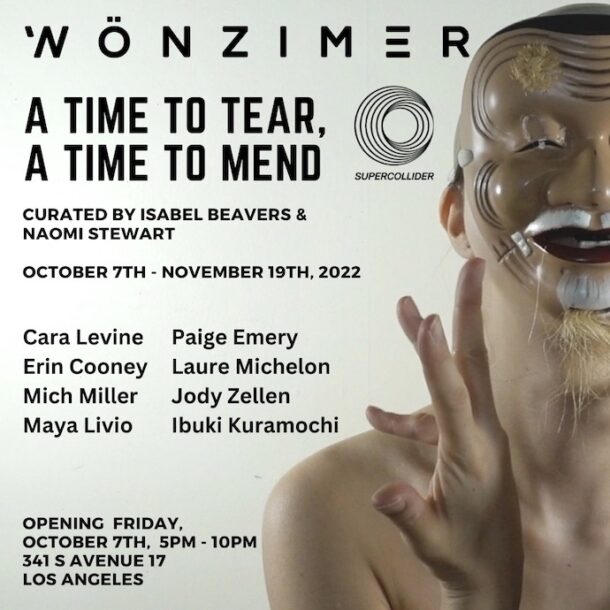
“A time to mourn and a time to dance
A time to tear and a time to mend
A time to be silent and a time to speak”
(Excerpt from Ecclesiastes 3)
a time to tear, a time to mend explores the advent of wisdom collection through ecological, historical, somatic, and technological artifacts. This exhibition asks: In the age of hyper-digitization, how can one assess, metabolize, and grieve traumatic events flashing across their timeline? How can one navigate information in a way that is healing and beneficial, both individually and communally? How can non-human ecologies inform our understanding of time and listening? What purpose do virtual and augmented realities serve in crafting our compass towards wisdom? Artists in SUPERCOLLIDER’s 2022 Sci-Art Ambassador cohort utilize AI, video, sculpture, painting, and performance to explore these questions.
Laure Michelon’s Machinic Reflection confronts bias in emerging technologies. A camera is placed strategically in the gallery that captures an image of any viewer in close proximity to the work. An algorithm trained on a curated dataset of categories. The proximate items on the vanity, [Mask.01.A] and [Mask.02.A] are AI-generated representations of the artist’s face. The masks serve as a type of tool or prosthetic through which the user could disrupt their classification originally deemed by Machinic Reflection.
Jody Zellen’s Photo News, January 1, 2019 – September 15th, 2022 (https://www.instagram.com/photonews5/) is a daily posting of a news image created each morning from the digital version of the New York Times. The result is an ambiguous montage that poetically references the original photograph, albeit reducing it to its most graphic and stylized form. It catalogs 4 years of tragedy and triumph in the news cycle.
Cara Levine’s Cried Listening to the News Again is a floating balloon installation that wrestles with grieving amid life at a break-neck pace. Stairs, presents the ghost of stability and structure through a foil cast while Fear Is A Liar, grapples with fear and horror in the public realm. Levine’s work contends with the emotional reality of the current moment through delicate formal gestures.
Erin Cooney’s Now a Room, Now a Landscape was created during Los Angeles’s March 2020 “Safer at Home” orders, which were imposed in response to the outbreak of COVID-19. Creating a labyrinth in her home using furniture and objects, Cooney walks with cameras situated on her feet in an embodied and internal journey.
HUMAN PERFORMER, by Ibuki Kuramochii mixes three faces – the face of my elderly self masculinized by AI, the face of a traditional elderly man, and the face of a traditional Japanese woman – to explore notions of tradition and essentialism. In the cultural matrix, what are the privileged values necessarily possessed by perceived gender and what does it mean to be a MAN = human being?
Mich Miller situates knowledge and connection in the archiving of personal histories of trans men and nonbinary individuals in their work husbands (Jacksonville, FL). Each piece holds testosterone vials sourced from one individual; each encapsulates a certain stretch of time and connects us to the intimate and transformative experience of the individual’s hands they passed through.
Maya Livio’s RE: Generative Images is a research-driven work-in-process on the material ethics of generative digital image-making, it is an experiment in rejecting technological progress narratives and embraces environmentally-informed methods as generative guardrails rather than limitations.
Paige Emery’s Methods for Descrying: the water shapes the plants and the plants shape the water is a contemplation on water scrying, a method of divination by which one gazes into water in a meditative state, employing intuition to pull out images that arise in sensory communion as guidance for the unknown. Divination by scrying does not so much look outwards toward the future but inwards to better understand one’s relationship with the future.
In a “post-pandemic” world, there is pressure to restore the status quo pre-2020. a time to tear, a time to mend invites visitors to consider alternatives to the status quo by fostering deeper connections to our bodies, other peoples, technology, and nature–to slow down and notice. These works offer space to metabolize and grieve trauma and loss, to rebuild and reimagine new ways of engaging with the world, to deepen our discernment in forming our opinions and disillusion us to paradigms that no longer serve us.
The exhibition will be on view at Wonzimer Gallery from October 7, 2022 – November 18, 2022.
Ibuki Kuramochi will perform on October 29, 2022 and Erin Cooney will present a workshop on October 15, 2022.

